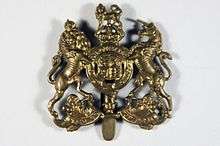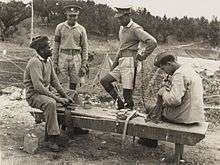General Service Corps
| General Service Corps | |
|---|---|
 Cap Badge of the General Service Corps | |
| Active | 1914– |
| Allegiance |
|
| Branch |
|
| Role | For specialists, not allocated to a regiment or corps |
| Beret | Dark blue |
The General Service Corps (GSC) is a corps of the British Army.
Role
The role of the corps is to provide specialists, who are usually on the Special List or General List.[1]
History
The corps was founded in 1914 at the outbreak of World War I for specialists and those not allocated to other regiments or corps.[2] It was used for similar purposes in World War II, including for male operatives of the Special Operations Executive (female operatives joined the FANY).[3][4]
From July 1942, army recruits were enlisted in the corps for their first six weeks so that their subsequent posting could take account of their skills and the Army's needs.[5] A similar role, holding some recruits pending allocation to their units, continues today.[6][7][8][9]
Insignia

From 1914, the cap badge has been the Royal Arms, with variously a king's or a queen's crown, depending on the reigning monarch. It bears the motto of the monarch 'Dieu et mon droit' and the Order of the Garter's motto 'Honi soit qui mal y pense'.[10]
As a result the GSC nickname was 'Crosse and Blackwell' after the firm whose tins and jar labels had a prominent royal coat of arms.[11]
In the British colony of Bermuda, there were three Territorial Army units at the outbreak of war, which were mobilised for the duration. Of these, the only one which accepted coloured (anyone who was not entirely of European heritage) recruits (as other ranks, with its officers either seconded from the regular army or commissioned from the ranks of the Bermuda Volunteer Rifle Corps or Bermuda Volunteer Engineers) was the Bermuda Militia Artillery, a reserve of the Royal Artillery that manned a single coastal artillery battery (St. David's Battery). Although a second battery was immediately added at Warwick Camp, the BMA could not make use of the available coloured manpower and a new regiment, the Bermuda Militia Infantry was formed in October, 1939, and split the infantry duties of the Bermuda Garrison with the BVRC and the resident regular army infantry company. The BMI was formed out of the BMA, was grouped administratively with it, and its personnel were absorbed into the BMA before demobilisation in 1946, but wore the General Service Corps cap badge instead of the Royal Artillery cap badge.[12]
Notable personnel
Notable members of the General Service Corps include:
- Walter Freud[13]
- Edward Harrison
- Peter Lake[14][15]
- T. E. Lawrence (Lawrence of Arabia)[16]
- Bob Maloubier[17]
- John Pendlebury[18]
- Arthur Staggs[19]
Order of Precedence
The corps is twenty-second in the British Army's order of precedence.[20]
| Preceded by Royal Army Physical Training Corps |
Order of Precedence | Succeeded by Queen Alexandra's Royal Army Nursing Corps |
References
- ↑ "Combat Service Support". armedforces.co.uk. Retrieved 10 May 2014.
- ↑ Imperial War Museum. "Badge, Headdress, British, General Service Corps". Retrieved 8 November 2017.
- ↑ Foot, M R D (2006). SOE in France: An Account of the Work of the British Special Operations Executive in France 1940-1944. Routledge.
|access-date=requires|url=(help) - ↑ Tillotson, M (2001). SOE and the Resistance as Told in the Times Obituaries. London: Continuum. p. xii.
|access-date=requires|url=(help) - ↑ William H. Beveridge (2014) [1943]. The Pillars of Security (Works of William H. Beveridge). Taylor & Francis. ISBN 978-1-317-57304-3.
- ↑ Vila, Maurice. "WW2 People's War". BBC. Retrieved 9 November 2017.
- ↑ Pigott, A J K (1960). Manpower Problems: The Second World War 1939-1945. London: The War Office.
|access-date=requires|url=(help) - ↑ Crang, J A (2000). The British Army and the People's War 1939-1945. Manchester University Press. p. 14. ISBN 978-0719047411.
- ↑ Heyman, C (2012). The British Army Guide 2012-2013. Pen and Sword Military. p. 144.
|access-date=requires|url=(help) - ↑ Imperial War Museum. "Badge, Headdress, British, General Service Corps". Retrieved 8 November 2017.
- ↑ Waugh, Evelyn (1977). Put Out More Flags. Little, Brown and Company. ISBN 978-0316926157.
- ↑ The Bermuda Regiment website: Brief History of the Bermuda Regiment
- ↑ van den Vat, Dan. "Walter Freud Obituary". THe Guardian. Retrieved 9 November 2017.
- ↑ Lake, Peter. "Daily Telegraph Obituary". Daily Telegraph. Retrieved 9 November 2017.
- ↑ Perrin, Nigel. "Peter Lake". Retrieved 9 November 2017.
- ↑ "Major Thomas Edward LAWRENCE". The National Archives. The National Archives. Retrieved 8 November 2017.
- ↑ Davidson, Phil. "Bob Maloubier Obituary". The Independent. Retrieved 9 November 2017.
- ↑ Grundon, Imogen (2007). The Rash Adventurer: A Life of John Pendlebury. Libri. ISBN 978-1901965063.
- ↑ Staggs, Arthur. "Arthur Staggs Obituary". The Daily Telegraph. Retrieved 9 November 2017.
- ↑ The Queen's Regulations for the Army, Chapter 8, Ceremonial (PDF). Retrieved 9 November 2017.